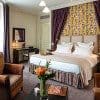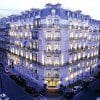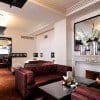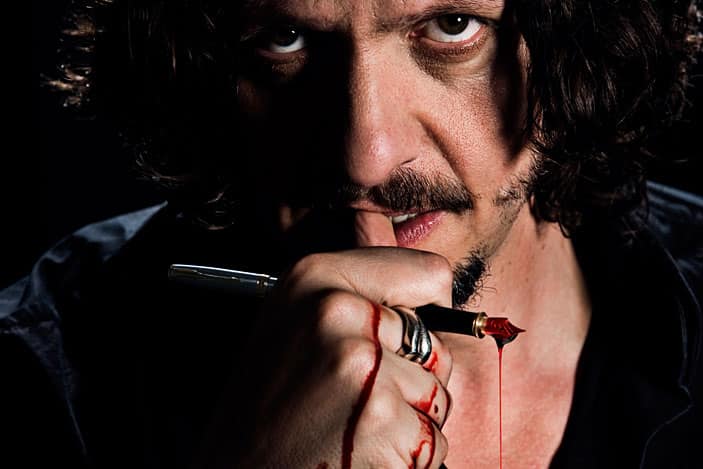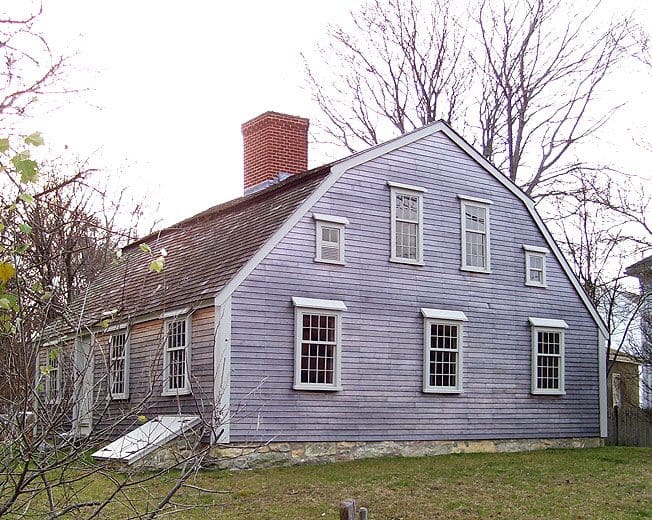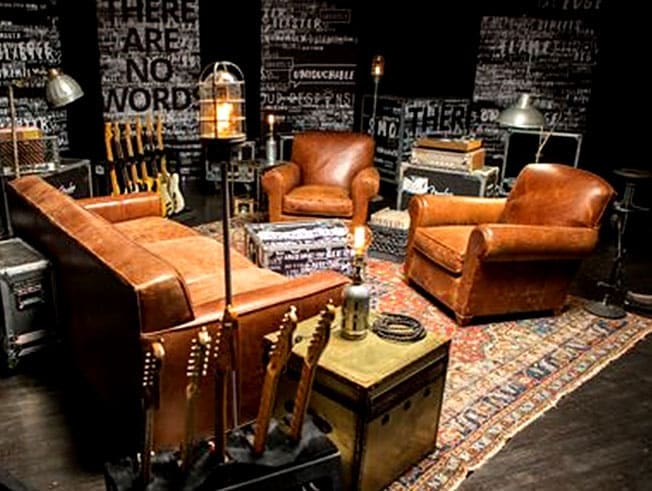How Paris became the true home of jazz – words Chris Zacharia
Leaning from a first-floor balcony, a grinning Louis Armstrong waves to the big brass band playing in the street below. On the next balcony along, Duke Ellington salutes the musicians. They’re playing saxophones and trumpets and trombones, drawing glances from pedestrians. It’s 1961, and Paris is alive with jazz music.
“That photo is our only remaining evidence that both Duke and Louis stayed at La Trémoille” says Marie, the hotel’s commercial manager. “We have nothing else left from that time”. A fascinating snapshot of a more freewheeling time, it’s an excellent memento for the hotel – the kind of achingly cool shot which makes you feel as though you were born in the wrong era.
Not that Hôtel de La Trémoille lacks a sense of its history. Gazing up at the elegant, Hausmann-era facade, you can feel the generations of Parisian city life coming to life. Inside, the classic style of the exterior is tempered by a quiet modern elegance.
Long-favoured by travellers who want a quintessentially Parisian hideaway, La Trémoille has that unmistakably authentic feel. It’s no surprise to learn that the hotel boasts an unusually high number of repeat guests, who often like to book ‘their’ room over and over. It feels more like staying in the antique home of an illustrious Parisian friend, rather than your standard hotel.
It might be five-star, but La Trémoille is not one of those gaudy, flashy hotels which shove opulence down your throat. Instead, the focus is on individuality, style and service. Each of the hotel’s ninety-two rooms is unique in some way, from the layout to the colour palette. And, of course, the hotel emphasises its jazz heritage; every Thursday guests can enjoy Bubbles & Jazz, an evening of live music and Champagne in the Louis2 restaurant lounge.
Yet Paris’s unique relationship with jazz music, stretching back for over a century, makes scenes such as those captured in the hotel’s cherished photograph almost commonplace. Since the arrival of jazz in 1913, the City of Lights has been home to some of the most vibrant jazz culture in the world. Situated in the splendour of the sought-after ‘golden triangle’ between between the Champs Élysées, Arc de Triomphe and the Seine, La Trémoille is well-placed to offer access to both the traditional sights of Paris and the more bohemian quarters synonymous with jazz music.
Despite the exoticism of Paris’s jazz scene, it’s remarkably accessible. I had never traveled by Eurostar before, but my journey from St. Pancras to Gare du Nord was, like most people’s, impressively smooth. Bypassing the airport means that you arrive feeling refreshed, especially after a delectable light lunch. With Raymond Blanc serving as culinary director for Eurostar, it’s a world away from ‘plane food’. We step off in the afternoon sunshine of Paris feeling rejuvenated and ready to explore.
Jazz arrived by night. From the beginning it was a clandestine love affair, igniting in one neighbourhood before spreading to another. Montparnasse, the fourteenth arrondissement on the old left bank, was the first neighbourhood to be brought to life by the music. The district’s artistic explosion of the 1920s, known as les Années Folles (‘the crazy years’) was spurred by the influx of Americans; in the three years between 1921 and 1924, the number of Americans in Paris increased sixfold, and many chose Montparnasse as their new home.
Saint-Germain-des-Prés, in the sixth arrondissement, experienced a similar flourishing of artistic sentiment in the 1940s. Home of the intellectual elite, Saint-Germain-des-Prés witnessed an extraordinary cross-pollination of disciplines which is almost unthinkable today.
Clara Ponty of Context Travel guides us around the district, revealing its hidden history. As the daughter of jazz violinist Jean-Luc Ponty, and a successful jazz musician in her own right, Ponty is exactly the kind of guide you want – intelligent, coherent and full of insightful anecdotes. Best of all, she has created a soundtrack to the tour on prepared iPods for guests, allowing you to feel the full visceral force of jazz as you meander through one of the most idyllic neighbourhoods in Paris.
It’s a beautiful stroll: cobblestoned avenues, markets boasting basketfuls of cabbages and red peppers, enormous fin-de-siecle townhouses with their proud shutters flung open. For the centre of such a big city, Saint-Germain-des-Prés has a cosy, almost village-esque feel to it, as though insulated from the pomp and power of the capital.
On a picturesque tree-lined boulevard, we encounter the sprawling Cafe des Flore. Jean-Paul Sartre, founder of existentialism and the closest any philosopher has ever come to rock-star A-lister status, worked daily at des Flore – which, in the manner of Parisian cafes at the time, was also a jazz club. Like many intellectuals of his era, Sartre enjoyed jazz music, which was then undergoing a cerebral turn. Bebop jazz was the result: constant changing of key, complex chord progressions and an emphasis on improvisation appealed to those devoted to the life of the mind.
Nestled quietly on a backstreet is another heirloom of the jazz age. From the outside, La Hotel Louisiana looks like your standard two-star bed and breakfast, with no clue that it was once the centre of the neighbourhood’s thriving jazz scene. The owner would cook up enormous batches of rice and beans to keep the musicians going, who jammed in the corridors until dawn. Bud Powell, the Bebop Pianist whose solo on the famous ‘Round Midnight’ is still considered the best of all time, lived in the hotel for months at a time, along with famous bebop drummer Kenny Clarke.
Despite the tumult of the past few decades, Paris is still a place where musicians can prosper. Thanks to a hungry audience, many jazz clubs are still in full swing today. A government grant known as the Intermittant du spectacle helps musicians to get by, giving them a cash sum if they have played more than forty live shows in eight months. It’s a genuflection which reveals the respect afforded to musicians in France, and especially in Paris.
Today, there is more jazz to be found across the Seine on the Right Bank. hit the Caveau de la Huchette for an unforgettable, rick-rollicking jazz night, in an atmospheric club with of real historical pedigree. Sitting imperiously above the river, Caveau de la Huchette was formerly the meeting place of Robespierre, who used the building – constructed by the Freemasons and used by the Knights Templar – to execute enemies with the Guillotine. Since 1946, it’s hosted jazz legends such as Danny Doriz, Al Copley and Memphis Slim, with live music from Jazz musicians every night of the week.
For a more intimate experience, the nearby Duc de Lombard is perfect. With the audience clustered around the stage, dominated by a baby grand, it hosts high-quality mainstream jazz, although at around €30 entry it is on the expensive side. Sunset Sunside, just around the corner on Rue des Lombards, is more affordable. Even at two-and-a-half hours, our walking tour with Clara only scratches the surface of Paris’s astonishing relationship with jazz music. We head back to the hotel still humming the catchy numbers from Clara’s iPods.
Back at the Hôtel de La Trémoille, we sit down for a much-needed meal at the hotel’s Louis2 restaurant. Offering intelligent yet unpretentious French bistrot fare, it’s the sort of quietly sophisticated restaurant you’d expect from such a well-kept boutique hotel. The food isn’t prissy, though – my pork chop, the size of steering wheel, is still sizzling from the pan as it arrives. It’s lucky that the food is so gutsy, because I’m utterly famished. The chop vanishes in the same instantaneous way big hams get chomped in cartoons.
As bedtime approaches, I open the balcony door on my third-floor room and gaze upon the Rue de la Trémoille, trying to imitate Louis Armstrong and Duke Ellington. Paris isn’t quite the bohemian paradise it once was, but thanks to places like Hôtel de La Trémoille, its unique heritage survives for the another generation to enjoy. The spirit of jazz – experimentation, improvisation, raw energy – still lives in a city which dances every night to the sound of the saxophone, trumpet, and piano.
For more information on Hotel de la Trémoille and the Paris Jazz scene, please visit www.tremoille.com/uk/index.php
EUROSTAR FACT BOX:
To enjoy some Paris Jazz music in the true home of Jazz then Eurostar operates up to 21 daily services from London St Pancras International to Paris Gare Du Nord with one-way fares starting from £29 (price based on a return journey).
Standard Premier fares from London St Pancras International to Paris Gare Du Nord start from £97.50 one-way (price based on a return journey).
Tickets are available from eurostar.com or 03448 224 777


